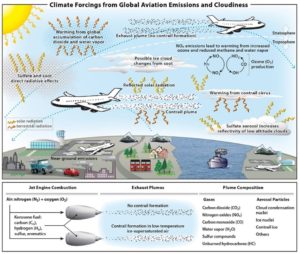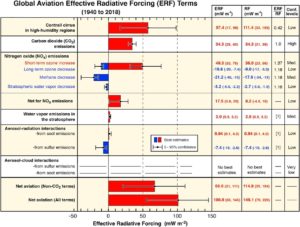Future aviation climate impacts: the role of aerosol emissions
This project will develop and use a state-of-the-art climate model to assess the climate impact of aviation aerosol emissions from current and future generation aircraft.
Background and context
Global aviation has grown rapidly during the last 50 years, with annually averaged emission growth rates accelerating from 2.2% during 1970-2012 to 5% during 2013-2018. While temporarily affected by the COVID-19 pandemic, existing forecasts indicate that this growth trend will continue. As a result, aviation is predicted to become the largest emitting sector in the UK by 2050 (Hirst, 2021).

Aviation currently contributes about 2.5% of the total global anthropogenic CO2 emissions, with a substantially larger overall effect on climate. The most recent aviation radiative forcing estimates indicate that the contribution of air traffic to global warming is roughly 3.5%, with a significant proportion (~60%) caused by non-CO2 effects (Lee et al., 2021). The largest of these non-CO2 effects are caused by aviation contrails (Rap et al., 2010; Kärcher, 2018) and emissions of NOx, water vapour and aerosols (see Figure 1). Despite significant recent progress in our understanding of the overall climate impact of air traffic, large uncertainties remain especially in terms of aerosol-cloud interactions resulting from soot and sulphur emissions. To date, there are still no best estimates for the climate impact of aviation aerosol-cloud interactions (see Figure 2; Lee et al., 2021).

Recognised as one of the most difficult industries to decarbonise, aviation has been under increasing pressure in recent years to substantially cut its impact on climate. The UK Sixth Carbon Budget set in 2021 includes for the first time international aviation in its pledge to reduce emissions by 78% by 2035 (UK Government, 2021). Several other ambitious targets have been set for aviation, including the International Air Transport Association commitment in October 2021 to achieve net-zero carbon emissions by 2050 (IATA, 2021). Achieving these targets rely heavily on a substantial proportion of future flights being operated by alternative fuel aircraft (Rap et al., 2021); aircraft manufacturers such as Airbus have already pledged to have the first commercial zero-emission aircraft fuelled by hydrogen in service by 2035. Thus, with net zero-carbon aviation being a near-term target, providing reliable estimates of all aviation climate impacts from current and future generation aircraft is now more important than ever.
Objectives
The aim of this project is to investigate the climatic effect of aviation aerosol emissions from current and future generation aircraft. The modelling approach will involve the use and development of the state-of-the-art UK Earth System Model, including the CASIM aerosol microphysics and the contrail cirrus schemes. While relatively flexible to allow for your interests, the project is likely to involve:
- A comprehensive assessment of aerosol emissions from current and future generation aviation, using a range of scenarios for air traffic and aircraft technology (e.g. alternative fuels).
- Quantifying the global radiative forcing of aerosol-radiation interactions from current and future generation aircraft.
- Using the existing CASIM aerosol microphysics scheme to investigate present-day aviation aerosol-cloud interaction effects in high air traffic regions (e.g. Europe, North America).
- Assess the global climate impact from aerosol-radiation interactions and aerosol-cloud interactions caused by switching to alternative fuel aircraft (e.g. hydrogen or fuel cells).
- Investigate the role of flight route optimisation (latitude/altitude effects) to minimise the climate impact of future generation aircraft.
Potential for high impact outcome
There are still large uncertainties in our understanding of the current aviation impact on climate and how it might evolve in the future. With access to state-of-the-art models and support from our world leading research groups, this project will address these uncertainties and will therefore have important implications for future climate projections. This will be of interest to both the general public and to policy makers working in climate mitigation and the transport sector. It is expected that findings from this project will be published in high impact journals and will be presented at international conferences.
Training
The student will work under the supervision of Dr Alex Rap, Prof Paul Field and Dr Dan Grosvenor and will be a member of the Physical Climate Change research group in SEE. The project provides an exciting opportunity to be trained in and exploit the new UK Earth System Model (UKESM) via collaborations with UK Met Office staff. The student will also be part of the Priestley International Centre for Climate that brings together world leading expertise in all the key strands of climate change research at the University of Leeds. Through the high level specialist scientific training associated with this project, the student will develop a comprehensive understanding of aviation impacts on climate and will work with state-of-the-art climate models. In addition, the student will learn how to communicate science and how to write high impact journal publications.
The successful PhD student will also have access to a broad spectrum of training workshops put on by the Faculty that includes an extensive range of training workshops in numerical modelling, through to managing your degree, to preparing for your viva. A full list of training opportunities is available here.
Eligibility requirements
A good first degree, Masters degree or equivalent in a quantitative science discipline (e.g. Physics, Mathematics, Chemistry, Atmospheric Science, Engineering) and a keen interest in global environmental problems. While a substantial part of this project involves computer modelling, prior experience is not essential – we provide high level specialist scientific training during the PhD.
References
-
- Hirst, 2021. Aviation, decarbonisation and climate change. House of Commons Library Research Briefing, 8826, 20 September 2021.
- IATA, 2021. Net-Zero Carbon Emissions by 2050, International Air Transport Association, Press release No 66, 4 October 2021.
- Karcher, 2018. Formation and radiative forcing of contrail cirrus, Nature Comm., 9, 1824.
- Lee et al., 2021. The contribution of global aviation to anthropogenic climate forcing for 2000 to 2018, Atmospheric Environment, 244, 117834.
- Rap et al., 2010. Parameterization of contrails in the UK Met Office climate model. J. Geophys. Res., 115, D10205.
- Rap A. et al., 2010. Estimating the climate impact of linear contrails using the UK Met Office climate model, Geophys. Res. Lett. 37(20).
- Rap et al., 2021, The impact of contrails and NOx emissions for FlyZero aircraft concepts with alternative fuel and energy systems, Fly Zero Report FZ_RB_001, ATI.
- UK Government, 2021. UK enshrines new target in law to slash emissions by 78% by 2035. Press release, 20 April 2021.
